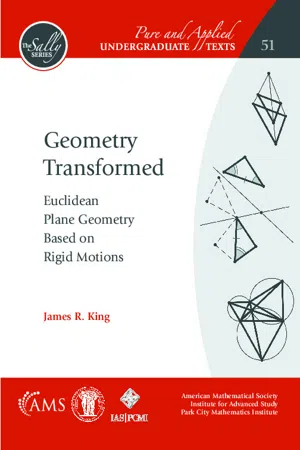Mathematics
Area of Regular Polygons
The area of a regular polygon is the measure of the space enclosed by the polygon's sides. To find the area, you can use the formula A = 1/2 * apothem * perimeter, where the apothem is the distance from the center to a side and the perimeter is the total length of the sides. This formula applies to all regular polygons, such as squares, hexagons, and octagons.
Written by Perlego with AI-assistance
Related key terms
1 of 5
10 Key excerpts on "Area of Regular Polygons"
- eBook - PDF
- Alberto D. Yazon(Author)
- 2019(Publication Date)
- Society Publishing(Publisher)
Perimeter and Area 97 In this way, a regular polygon is a tangential polygon. A regular n-sided polygon can be structured with the help of the compass and straightedge if and only if the odd prime factors of n are distinct Fermat primes. 4.12.1. Area of the Polygon The formula to evaluate the area of a regular polygon can be written as: A = (1/2) × a × P where, P is the perimeter; a is the apothem. 4.13. PARALLELOGRAM FORMULA The parallelogram is a geometrical figure which is consisting of four sides formed with the help of the two pairs of parallel lines. Opposite sides are having the equal length and opposite angles are equal in amount. The base, as well as height of a parallelogram, must be perpendicular with respect to each other. Never the less, the lateral sides of a parallelogram are not perpendicular with respect to the base. In this way, a dotted line is drawn to represent the height. The area of a parallelogram is also equal to the magnitude of the vector cross product of two adjacent sides. The area of a triangle created with the help of one of its diagonals. A picture of a leaning box or rectangle is the best example of a parallelogram. 4.13.1. Perimeter The perimeter is the sum of the length of all the 4 sides. The perimeter of a parallelogram is the total distance outside the geometrical shape. The opposite side of a parallelogram is equal and so the perimeter becomes twice the sum of base and height. The perimeter of a Parallelogram Formula is given as, Perimeter of a Parallelogram= 2 * (Base + Height) 4.13.2. Area Area = b × h In this way, where, b is the length of any base and h is the corresponding altitude or height. Introduction to Mathematical Literacy 98 REFERENCES 1. Art Foundations, (2019). Element of Design Shape . [online] Wcs.k12. mi.us. Available at: http://www.wcs.k12.mi.us/cousino/wcsart/art%20 foundatons%20site/shape.html (Accessed on 17 August 2019). 2. BrainPOP (2019). Perimeter – BrainPOP Jr. . [online] Jr.brainpop.com. - No longer available |Learn more
- Daniel C. Alexander, Geralyn M. Koeberlein, , , Daniel C. Alexander, Geralyn M. Koeberlein(Authors)
- 2014(Publication Date)
- Cengage Learning EMEA(Publisher)
CHAPTER OUTLINE 8.1 Area and Initial Postulates 8.2 Perimeter and Area of Polygons 8.3 Regular Polygons and Area 8.4 Circumference and Area of a Circle 8.5 More Area Relationships in the Circle ■ PERSPECTIVE ON HISTORY: Sketch of Pythagoras ■ PERSPECTIVE ON APPLICATIONS: Another Look at the Pythagorean Theorem ■ SUMMARY Chapter 8 © Glowimages/Getty Images 341 Powerful! The unique shape and the massive size of the Pentagon in Washington, D.C., manifest the notion of strength. In this chapter, we introduce the concept of area. The area of an enclosed plane region is a measure of size that has applications in construction, farming, real estate, and more. Some of the units that are used to measure area include the square inch and the square centimeter. While the areas of square and rectangular regions are generally easily calculated, we will also develop formulas for the areas of less common polygonal regions. In particular, Section 8.3 is devoted to calculating the areas of regular polygons, such as the Pentagon shown in the photograph. Many real-world applications of the area concept are found in the examples and exercise sets of this chapter. Areas of Polygons and Circles Additional video explanations of concepts, sample problems, and applications are available on DVD. Copyright 2013 Cengage Learning. All Rights Reserved. May not be copied, scanned, or duplicated, in whole or in part. Due to electronic rights, some third party content may be suppressed from the eBook and/or eChapter(s). Editorial review has deemed that any suppressed content does not materially affect the overall learning experience. Cengage Learning reserves the right to remove additional content at any time if subsequent rights restrictions require it. 342 CHAPTER 8 ■ AREAS OF POLYGONS AND CIRCLES Unless otherwise noted, all content on this page is © Cengage Learning. Lines are said to be one-dimensional because we can measure only the length of a line segment. - eBook - PDF
- Daniel C. Alexander, Geralyn M. Koeberlein(Authors)
- 2019(Publication Date)
- Cengage Learning EMEA(Publisher)
8.3 ■ Regular Polygons and Area 377 9. In a particular type of regular polygon, the length of the radi- us is exactly the same as the length of a side of the polygon. What type of regular polygon is it? 10. In a particular type of regular polygon, the length of the apo- them is exactly one-half the length of a side. What type of regular polygon is it? 11. In one type of regular polygon, the measure of each interior angle 1 I 5 (n 2 2)180uni00B0 n 2 is equal to the measure of each central angle. What type of regular polygon is it? 12. If the area (A 5 1 2 aP) and the perimeter of a regular polygon are numerically equal, find the length of the apothem of the regular polygon. 13. Find the area of a square with apothem a 5 3.2 cm and perimeter P 5 25.6 cm. 14. Find the area of an equilateral triangle with apothem a 5 3.2 cm and perimeter P 5 19.2 !3 cm. 15. Find the area of an equiangular triangle with apothem a 5 4.6 in. and perimeter P 5 27.6 !3 in. 16. Find the area of a square with apothem a 5 8.2 ft and perimeter P 5 65.6 ft. In Exercises 17 to 30, use the formula A 5 1 2 aP to find the area of the regular polygon described. 17. Find the area of a regular pentagon with an apothem of length a 5 5.2 cm and each side of length s 5 7.5 cm. 18. Find the area of a regular pentagon with an apothem of length a 5 6.5 in. and each side of length s 5 9.4 in. 19. Find the area of a regular octagon with an apothem of length a 5 9.8 in. and each side of length s 5 8.1 in. 20. Find the area of a regular octagon with an apothem of length a 5 7.9 ft and each side of length s 5 6.5 ft. 21. Find the area of a regular hexagon whose sides have length 6 cm. 22. Find the area of a square whose apothem measures 5 cm. 23. Find the area of an equilateral triangle whose radius measures 10 in. 24. Find the approximate area of a regular pentagon whose apothem measures 6 in. and each of whose sides measures approximately 8.9 in. - eBook - PDF
Geometry Transformed
Euclidean Plane Geometry Based on Rigid Motions
- James R. King(Author)
- 2021(Publication Date)
- American Mathematical Society(Publisher)
Chapter 9 Area and Its Applications Areas of Triangles and Parallelograms Area, a familiar and useful topic in the real world, is not only an interesting topic in geometry; it also provides an additional tool for understanding geometrical relation-ships. While it is simple in some respects, it is not so simple in others. The simple part includes the familiar formulas for areas of rectangles, triangles, parallelograms, and other basic polygons. The not-so-simple part is expressing a general definition of area and then proving it agrees with the simple formulas but also applies to shapes such as circles and other nonpolygonal shapes. To derive an area formula for circles, limits are involved. This is as far as we will be going in this book. 1 Area should have these properties: • Congruent figures have the same area. • For a square ? of side length 1, the area 𝒜(?) = 1 . • If the set ? 1 contains ? 2 , then 𝒜(? 1 ) ≥ 𝒜(? 2 ) . • If a set ? is the union of a finite number ? 1 , ? 2 , ... , ? 𝑘 of convex polygons and their interiors such that the polygon interiors do not intersect, then 𝒜(?) = 𝒜(? 1 ) + 𝒜(? 2 ) + ⋯ + 𝒜(? 𝑘 ). Squares and the Definition of Area. All our work with area will rely on the areas of squares. Consider how only one definition makes sense. A square of integer side 𝑚 can be divided into 𝑚 2 unit squares of side 1, so the area should be 𝑚 2 . For example, the square on the left of Figure 1 is 9, assuming the small squares have side 1. If the area of a square of side 1 is divided into squares of side length 1/𝑛 , then since there are 𝑛 2 such small squares, the area of the small square should be 1/𝑛 2 . The area of 1 If one investigates really complicated sets in the plane, such as fractals, it turns out that a set may have no area, or it may have more than one value competing to be area. 161 - No longer available |Learn more
- (Author)
- 2014(Publication Date)
- Library Press(Publisher)
(Thus we consider something like the winding number of the orientation of the sides, where at every vertex the contribution is between −½ and ½ winding.) Area and centroid Nomenclature of a 2D polygon ________________________ WORLD TECHNOLOGIES ________________________ The area of a polygon is the measurement of the 2-dimensional region enclosed by the polygon. For a non-self-intersecting (simple) polygon with n vertices, the area and centroid are given by: To close the polygon, the first and last vertices are the same, i.e., x n , y n = x 0 , y 0 . The vertices must be ordered clockwise or counterclockwise; if they are ordered clockwise, the area will be negative but correct in absolute value. This is commonly called the Surveyor's Formula. The formula was described by Meister in 1769 and by Gauss in 1795. It can be verified by dividing the polygon into triangles, but it can also be seen as a special case of Green's theorem. The area A of a simple polygon can also be computed if the lengths of the sides, a 1 , a 2 , ..., a n and the exterior angles, are known. The formula is The formula was described by Lopshits in 1963. If the polygon can be drawn on an equally spaced grid such that all its vertices are grid points, Pick's theorem gives a simple formula for the polygon's area based on the numbers of interior and boundary grid points. If any two simple polygons of equal area are given, then the first can be cut into polygonal pieces which can be reassembled to form the second polygon. This is the Bolyai-Gerwien theorem. The area of a regular polygon is also given in terms of its inscribed circle of radius r by . The area of a regular n-gon inscribed in a unit circle is ________________________ WORLD TECHNOLOGIES ________________________ . The area of a regular n-gon is given in terms of its circumscribed circle with radius R by . - eBook - PDF
Geometry
A Self-Teaching Guide
- Steve Slavin, Ginny Crisonino(Authors)
- 2004(Publication Date)
- Wiley(Publisher)
Squares, rectangles, trapezoids, and parallelograms are all quadrilaterals. And a quadrilateral, as you may recall from chapter 1, is a four-sided polygon. Squares As you might well know, a square contains four right angles (angles of 90°) and has four sides of equal length. s s s s 126 GEOMETRY Perimeter of a square formula: P = 4s, where s stands for the length of a side. Here’s a nice easy one: Find the perimeter of the following square. P = 4s = 4(2) = 8. The perimeter is 8 feet. Now here’s a challenge. Find the area, A, of this same square. Area of a square formula: A = s 2 A = s 2 = 2 2 = 4. The area is 4 square feet. Rectangles A rectangle contains four right angles (90°), a pair of equal lengths, and a pair of equal widths. Perimeter of a rectangle formula: P = 2l + 2w Using this formula, find the perimeter of the following rectangle. P = 2l + 2w = 2(4) + 2(6) = 8 + 12 = 20. The perimeter is 20 inches. w = 4 inches = 6 inches w w s = 2 feet Perimeter and Area of Two-dimensional Polygons 127 Area of a rectangle formula: A = lw Go ahead and find the area of this rectangle. A = lw = 6(4) = 24. The area is 24 square inches. Example 1: Find the area of a rectangle if the length is 15 and the perimeter is 50. Solution: To find the area, first we have to find the width. We’ll use the formula for perime- ter to find the width. P = 2l + 2w Substitute 15 for l and 50 for P. 50 = 2(15) + 2w 50 = 30 + 2w Subtract 30 from both sides of the equation. 20 = 2w Divide both sides of the equation by 2. 10 = w The width is 10. Now that we know the width, we can substitute its value into the formula for area. A = lw A = 15(10) = 150 Example 2: Find the perimeter of a rectangle if its width is 9 inches and its area is 117 square inches. Solution: To find the perimeter, we have to find the length of the rectangle. We know the area, so we’ll start by using the area formula to find the length. - eBook - PDF
- John Peterson, Robert Smith(Authors)
- 2018(Publication Date)
- Cengage Learning EMEA(Publisher)
G e o m e t r i c F i g u r e s : A r e a s a n d Vo l u m e s S E C T I O N V Copyright 2019 Cengage Learning. All Rights Reserved. May not be copied, scanned, or duplicated, in whole or in part. Due to electronic rights, some third party content may be suppressed from the eBook and/or eChapter(s). Editorial review has deemed that any suppressed content does not materially affect the overall learning experience. Cengage Learning reserves the right to remove additional content at any time if subsequent rights restrictions require it. 654 OBJECTIVES After studying this unit you should be able to ■ compute areas of common polygons, given bases and heights. ■ compute heights of common polygons, given bases and areas. ■ compute bases of common polygons, given heights and areas. ■ compute areas of more complex figures that consist of two or more common polygons. ■ solve applied problems by using principles discussed in this unit. Many occupations require computations of common polygon areas in estimating job materials and costs. It is also sometimes necessary to find unknown lengths, widths, and heights of polygons when the areas are known. Methods of computing areas, sides, and heights of rectangles, parallelograms, trap-ezoids, and triangles are presented in this unit. The areas of complex polygons are found by dividing the complex polygons into two or more of these simpler figures. 26–1 AREAS OF RECTANGLES A rectangle is a four-sided polygon with opposite sides equal and parallel and with each angle equal to a right angle. The area of a rectangle is equal to the product of the length and width. A 5 lw where A 5 area l 5 length w 5 width EXAMPLES 1. A rectangular platform is 24 feet long and 14 feet wide. Find the area of the platform. A 5 24 ft 3 14 ft A 5 336 sq ft Ans 2. Determine the area, in square meters, of a rectangular strip of sheet stock 24 centimeters wide and 3.65 meters long. To find the area in square meters, express both the length and width in meters. - eBook - PDF
Mathematics for Elementary Teachers
A Contemporary Approach
- Gary L. Musser, Blake E. Peterson, William F. Burger(Authors)
- 2013(Publication Date)
- Wiley(Publisher)
Then, through talking about their models, the students are able to learn and use new vocabulary in a meaningful way (Koester, 2003). Common Core – Grade 6 Represent three-dimensional figures using nets made up of rectangles and triangles, and use the nets to find the surface areas of these figures. Apply these techniques in the context of solv- ing real-world and mathematical problems. 624 Chapter 12 Geometric Shapes Since there are infinitely many types of polygons to use as the bases, there are infinitely many types of prisms. Pyramids are polyhedra formed by using a polygon for the base and a point not in the plane of the base, called the apex, that is connected with line segments to each vertex of the base. Figure 12.94 shows several pyramids, named according to the type of polygon forming the base. Pyramids whose bases are regular polygons fall into two categories. Those whose lateral faces are isosceles triangles are called right regular pyramids. Otherwise, they are oblique regular pyramids. Right triangular pyramid Right square pyramid Oblique square pyramid Right pentagonal pyramid Figure 12.94 Polyhedra with regular polygons for faces have been studied since the time of the ancient Greeks. A regular polyhedron is one in which all faces are identical regular polygonal regions and all dihedral angles have the same measure. The ancient Greeks were able to show that there are exactly five regular convex polyhedra, called the Platonic solids. They are analyzed in Table 12.10, according to number of faces, ver- tices, and edges, and shown in Figure 12.95. An interesting pattern in Table 12.10 is that F V E + = + 2 for all five regular polyhedra. That is, the number of faces plus ver- tices equals the number of edges plus 2. This result, known as Euler’s formula, holds for all convex polyhedra, not just regular polyhedra. For example, verify Euler’s formula for each of the polyhedra in Figures 12.92, 12.93, and 12.94. - Alan Sultan, Alice F. Artzt(Authors)
- 2017(Publication Date)
- Routledge(Publisher)
Figure 4.53 of the launch, presented quite a challenge. It took mathematicians over 1000 years to go from finding areas of polygons to finding areas of irregular figures. What follows are some methods that have been developed over many years. (Note that the study of calculus was the primary tool that enabled us to make the hurdle from finding the area of polygons to finding the area of irregular shapes. However, since calculus is often taught in the upper levels of high school, we have saved this discussion for the end of the chapter, which will end in an examination of how calculus is used to find volume.)So, how on earth can we approach finding the area of the irregular shape presented in Figure 4.53(b) ? Thinking back to the definition of area (the number of square units a figure encompasses), one might think that it would be good to place the figure on a grid and count the number of squares inside and on the boundary of the figure. For example, we can put it on a grid as shown in Figure 4.54 , and count the number of squares that are inside the figure or that cut the boundary of the figure. The squares have to be in standard units. For example, if we are on a map and we are measuring the area of New York state, a possible standard unit for the length of a square might be 100 miles.Figure 4.54In the figure we count 38. So we estimate the figure to have 38 square units where a square has some kind of standard measure. To get a finer approximation to the area, we can subdivide the squares in the grid further and further into halves, quarters, and so on. This is tedious but will give a better approximation to the area of the figure and has the advantage that we need only use the area of squares to refine our estimate.One of the many triumphs of calculus is that we can find exact areas of certain irregular objects. Of course, you learned how to do this in calculus. We assume that you remember the basic integration facts from calculus, but quickly review them in this section. If the graph of f (x ) was above the x -axis as in Figure 4.55 and you wanted to find the area under the curve from x = a to x = b (the shaded area), you simply computed∫ a bf( x )d x .- eBook - PDF
College Geometry
A Unified Development
- David C. Kay(Author)
- 2011(Publication Date)
- CRC Press(Publisher)
Since these facts are intuitively clear and will not be used later, we leave the proof for a problem. The end result is: Corollary A given regular polygon possesses a center O and can be inscribed in a circle. An interesting diagram—found frequently as a poster in geometry class-room exhibits—is shown in Figure 4.22. It illustrates some of the general results which can be established for unified geometry (notably, in Problems 4 and 11), as well as calculations which can be made in Euclidean trigonometry for regular polygons. The formulas needed can be deduced as follows (taken from a typical high school geometry text), where A measures the central angle, s the side, r the radius of the circum-scribed circle, a the apothem, P the perimeter, and K the area: A n n s r A a r A P ns K Pa nr A = -= = = = = 180 2 2 ( ), cos , sin , , sin ½ ½ ½ ½ ½ 2 182 College Geometry: A Unified Development Figure 4 .22 The regular 24-gon and its diagonals. Data Number of diagonals: 252 Side: 0.261 052 3844 Radius: 1 (unit) Apothem: 0.991 444 8614 Diameter: 2 Perimeter: 6.265 257 227 Central angle: 15° Area: 3.105 828 541 (Pi = 3.141 592 654) Approximation to pi : ½ Perimeter = 3.132 626 614 Quadrilaterals, Polygons, and Circles 183 Problems.(Section.4 .4) Group A 1. The very first proposition proven in the Elements was the existence of an equilateral triangle. Euclid’s proof was essentially a compass, straight-edge construction, and went like this (see Figure P.1): Given any segment AB , describe a circle with center A and radius AB passing through B . Now, with center B and radius AB describe a circle passing through A . From the point C , in which the two circles cut one another, draw the segments CA and CB , thereby forming a triangle ABC . It is seen that AC = AB = BC and Δ ABC is equilateral. What essential detail was missing? B C A Figure P .1 2. In Euclidean geometry, the angle-sum of a triangle is 180.
Index pages curate the most relevant extracts from our library of academic textbooks. They’ve been created using an in-house natural language model (NLM), each adding context and meaning to key research topics.









